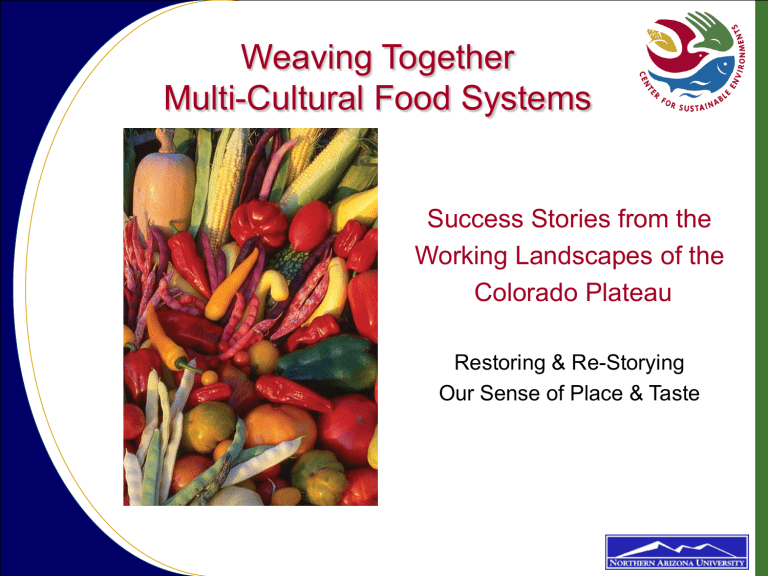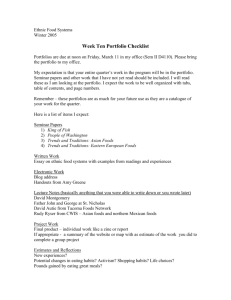Nabhan_ag_hybrid

Weaving Together
Multi-Cultural Food Systems
Success Stories from the
Working Landscapes of the
Colorado Plateau
Restoring & Re-Storying
Our Sense of Place & Taste
A Place of Unparalleled Food Diversity:
“[These peoples of America are] much inclined
To cultivate the earth and steward the same.
They harvest beans, corn, and squashes,
Melons and rich sloes of Castile,
And grapes in quantity throughout their landscape…
They harvest the red wheat and garden fare
Such as lettuce and cabbage, green beans and peas,
Cilantro, carrots, turnips, garlic,
Onions, artichokes, radishes and cucumbers.
They have pleasing herds of turkeys
In abundance and fowl of Castile, too,
Beside sheep and cattle and goats.”
~ Gaspar Pérez de Villagrá, 1598
A Regional Heritage Undergoing
Dramatic Agricultural Renewal
-Oldest agricultural history in the U.S.
-Greatest native crop diversity in Americas north of Tropic of Cancer
-Greatest agro-habitat diversity in one region
(sea level to 8500 ft.)
-Exciting restoration of springs, terraces, ak-chin fields, orchards & food rituals now in process among at least 10 cultures
-.
Reviving rare livestock breeds and ranching traditions
• Key sites for revival of heritage turkeys
• Oldest sheep breed in U.S.
(Navajo-Churro) SUBJECT
OF Slow Food’s first
Presidia revitalization
• Oldest cattle breed (Criollo
Corriente) now recovered
• Key stage for conservation collaborations among ranchers and conservation biologists
Pressures Mount,
Perils Persist!
Endangerment
Since WWII, Sunbelt has had most rapid urbanization/conversion of working landscapes in American history
Fragmentation of ranch- and farmlands
Usurpment of water by cities
60% of native crop varieties lost from
North America,1492-2002.
Loss of traditional knowledge about food biodiversity =
•
> avg. loss of farmers
• breaking of ancient traditions
Farm Economies, US Southwest
State Arizona Colorado New
Mexico
29,000 15,200 Number of farms
7,500
Avg. farm size (acres)
4,359
Prime ag acres converted/ developed
17,100
1,154
10,100
3,259
3,600
Utah
15,500
848
17,800
Health consequences of losing land access & food biodiversity
Impacts
Loss of many protective phytochemicals (eg., capsaicin, inulins) in traditional diet that sustained health
Loss of freshness, diversity and equitable access to safe food
Highest incidence of adultonset diabetes in world, major cause of death and disability
Nutrient-depleted convenience foods replaced traditional crops and wild foods
Government surplus commodity “hand-outs” were richer in fat & sugar, poorer in minerals & protein than native crops they replaced
Hand-outs served as disincentives for “growing your own,” resulting in less fresh, vitamin-rich vegetables
Use of wild foods from gardens declined as well
Reversing the Downward Spiral
SAVING THE PIECES!
Revitalization of uniquely
American food resources and the traditional cultural knowledge associated connected with these foods.
Rescuing, documenting, restoring:
Native American and Hispanic vegetable crops
Regionally-adapted heirloom grains
Spanish-introduced fruit and nut trees
Wild native plant foods
Regionally-adapted livestock breeds
Ranching traditions
Sowing Solar-Powered
Sustainable Agriculture
Breaking addictions to fossil fuel, returning to solarpowered strategies on the land
Breaking addictions to irrigation water imported from other watersheds or geological strata
Rebuilding distribution networks that combine local with fairly-traded extra-local
Combining traditional knowledge with agroecological science
Re-weaving the Regional
Food Network in the
Southwest
• Southwest Community Food and Agriculture
Outpost
• Traditional Native American Farmers Association
• Southwest Direct Marketing Network
• Northern Arizona Food and Agriculture Council’s
Canyon Country Fresh Network
• Quivira Coalition
• Native Seeds/SEARCH
• Community Food Connections
• Saving the Wide Open Spaces Forum
• Slow Food Southwest Convivia (8)
Shared Goals:
Cultural
Rescuing traditional agroecological knowledge
Rediscovering the region’s culinary history
Sustaining communities of farmers, ranchers and foragers
Reviving traditional food festivals, ceremonies, & seed exchanges
Shared Goals:
Health & Nutrition
Reviving wild foods that once prevented diabetes: prickly pear, chia, mesquite, acorns, Navajo tea
Reviving traditional crops that prevented diabetes: tepary and lima beans,
Jerusalem artichokes, cultivated cacti and agaves
Introducing fresh greens year-round
Fostering local processing w/o sugar and fat
Making Sure That Working
Landscapes Aren’t Squashed
Designating National Heritage Areas
Designating American Viticultural Areas
Pioneering Rural Planning Districts
Promoting County or Watershed-Wide Protection Plans
Making the most enduring rural traditions economically & ecologically viable again:
100s of Velarde NM grassroots entrepeneurs
Linking a sense of place to a sense of taste to keep rural communities viable
Linking the identities of consumers & producers as “co-producers ”
Re-storying Success:
Navajo-Churro Sheep
Oldest extant sheep breed in
North America
Historic neglect & intentional flock reductions imperiled its’ survival —less than 5,000 left by 1970
Recent revival thanks to direct marketing of wool and lamb by Dine Be’iina, Navajo
Churro Sheep Association,
Black Mesa Weavers Guild, and Canyon Country Fresh.
First Slow Food USA Presidia initiated, May 2005
Survey shows consumer support for place-based heritage foods
Likelihood of Purchasing Traditional Arizona
Food
Very likely
Somewhat likely
Somewhat unlikely
Don't know
0% 10% 20% 30% 40%
57% of those likely to purchase traditional, local foods are willing to pay 10% more for them.
Survey conducted March 2005 by the Social Research Laboratory at NAU.
The key to placebased nichemarketing:
Telling the stories of colorful foods with unique flavors and their role in our culture and destiny.
Current Needs in Region
Building multi-cultural partnerships to ensure equity and continuity in working landscapes
Assessing current disincentives to landscape-level conservation & viability of rural communities
Attracting diversified funding support to a region with few economic resources (incl. foundations)
Building “food system” management capacity at the local and regional levels
Encouraging residents to fully tell their stories of the land
Thanks to our donor and to our community elders, both of whom guide and inspire us
For more information on Canyon
Country Fresh and Renewing
America’s Food Traditions, see www.environment.nau.edu/food/






